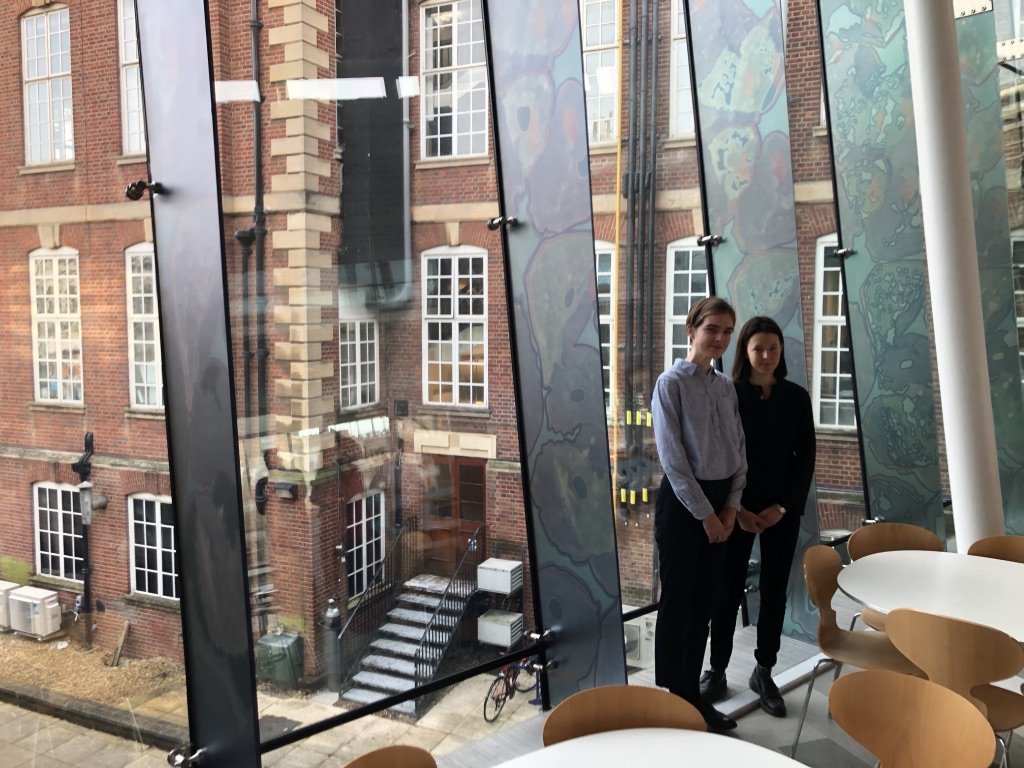Since 2014, The Sir William Dunn School of Pathology and the Ruskin School of Drawing and Fine Art have run a collaborative competition which aims to draw together the fields of the arts and the sciences. Mihaela Man and Olivia Williamson won the 2019 competition with a two-part piece which has been installed in the Dunn School café. I met with them to chat about their inspiration, creative process and final piece.


Light is a core concept of the Dunn School installation. O and M spoke with scientists at the Dunn School who explained principles of how light microscopy is used to visualise cellular detail. Microscopy involves the precise adjustment of light and exposure: too little light gives dim and coarse images, too much can cause damage to cells destroying finer detail. They were also introduced to fluorescence microscopy, a technique which involves visualising subsets of cellular components with different wavelengths of coloured light. For example, proteins which are tagged with GFP (green fluorescent protein) can be visualised under light in the blue to ultraviolet range. It is only by integrating information derived from images generated under different wavelengths, that a more complete picture of cellular events can be discerned.
O and M held these principles at the core of their creative interpretation of the work carried out at the Dunn School. Both outdoor natural and indoor artificial light penetrate the window installations, allowing illuminated visualisation of the field of cells which varies with the time of day and weather outside. There are 7 window panels, each depicting the same cells but at different focal planes, moving from the proximal cell surface through to the distant cell base. O and M also are aware that the materials that the window screens are made out of may be faded from continual light exposure, reflecting the effects too much light can have on cellular samples as well. The temporary part of the installation illustrates the ‘by-parts’ information like that from fluorescence microscopy, while the permanent installation, generated by rendering all layers into a flat, transparent image, depicts the whole, integrated image of the cell.
The window pieces in the Dunn School café serve an additional purpose – creating a space for thinking – as O puts it. You can’t help but look beyond the windows to the outside, to first the Dunn School’s little zen garden and then beyond towards University Parks. The artists thought this placement allows the mind to drift away; they believe that when ‘[one] allows the imagination to go, that’s when a lot of breakthroughs can happen’, irrespective of art or science. O and M noticed how their creative backgrounds in set design provided a backdrop from where these ideas could take hold. O described how in set design, stories are to be converted into psychological spaces in which the story can best unfold. The same principle stands in their installation, O and M hope that the story, or the progress of science, will be aided by the way the installation provides a psychological space for imagination.
The artists had meetings and discussions with scientists at the Dunn School, learning about projects, techniques and data produced. The artists then went on to use this new information to best inform their own work. It is clear from the outcome that the artists were thoughtful and respectful, holding core principles and scientific fact in a position of high importance while simultaneously using creative interpretation to produce a final piece which is both beautiful and striking. M described how this weaving together of scientific information and artistic interpretation was almost like combining fact with fiction. She described the starting point photo they used as ‘fact’ and explained that in approaching this image as an outsider, fiction began to seep in as they ‘attempted to figure out how that image worked from our own [artistic] perception’.
As well as closely collaborating with the scientists at the Dunn school, the artists also made use of collaborations in the Ruskin drawing ties between media, sculpture and printing to gain a final end product. However, the most obvious collaboration behind this work is the one between O and M themselves. They told me about a conversation they had over the summer holidays in which O was in an early morning time zone preparing to go to a building site in New York, while M was in a family-filled car in Romania in the afternoon. The two swapped ideas about the project while checking they were talking about the same photo-shopped version of the image. Their hard work has paid off, evident from the delighted crowd of Dunn school members at the installation’s official opening.

M explained that she thought that ‘cross-collaborations between science and arts have emerged as a means to try and generate a universal language that can be understood and accessed by each and every one of us. In the process of trying to carry a message, empathy can be generated if different people with different views come together to make something.’ The installation itself is a thing to be admired but the collaboration and message it represents are truly uplifting and hopeful.





